Trawlers Midwest had three of these new cats to deliver to their dealership in Manitowoc, Wisconsin. Our captains and first mates included Ken & Karen Schuler, owners of Trawlers Midwest, Captain Dan & Laura Cypher from Tawas, Michigan and Lou & Gloria Draeger from Springs Lake, Michigan. All of these couples have experience with long-range cruising. The Schulers have made this trip twice with the PDQ’s taking the route across Lake Ontario, through the Welland Canal, to Lakes Erie, Huron, and Michigan. This alternative waterway would be the first trip through the Trent Severn for all three couples.
A reception in the Whitby Marina Clubhouse the first evening was hosted by the PDQ staff. The President of PDQ, Simon Slater, was our chef and his wife, Debbie, was the hostess. The food and fellowship were great as it was a good chance to mix with the other owners, other PDQ dealers, and the PDQ staff.
Monday May 15 & 16
The next two days, the PDQ staff and invited speakers put on the PDQ-U (U for University) that gave us “hands-on” as well as technical information on all the systems on a PDQ 34 Power Catamaran. |
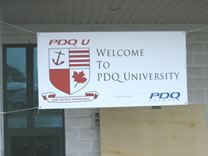
Whitby Marina |
The couples were divided into four male and four female groups so each group could rotate through the four sessions in the two-day event.
One session included an overview of the Raymarine electronics on the boat and the electrical system which includes a Prosine inverter, the microprocessor that serves as a 2000 watt inverter and battery charger.
A second session involved a thorough tour of a new PDQ going over all the systems on the boat, how they function, and what you need to know to operate them.
A third session was the on-the-water portion and hands-on learning with Nanette Kruze, a private captain, for the women and James Power, a PDQ captain and traveling PDQ repairman for the men. Each participant had an opportunity to dock the boat.
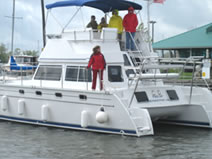
Docking session for women |
The fourth session involved learning about the Yanmar engine and Northern Lights generator from representatives of each company.
With the sessions ending at four in the afternoon, we all had ample time to stock our boats with the needed groceries and supplies and, of course, do some socializing as well.
|
Wednesday May 17
There was excitement in the air as we all did our final checks and filled up with fuel courtesy of PDQ. At nine we met in the club house for the skippers meeting. Ken Schuler led those in attendance in five verses of “AMAZING GRACE” as our farewell song, a traditional song for mariners leaving on a long journey. Today would be a 40-mile run on Lake Ontario from Whitby to Cobourg where all fifteen PDQ’s and their crews would spend one last dinner and evening together before the group split into three different flotillas.
As noon approached the PDQ staff began releasing the boats one at a time. What a parade it was with 15 PDQ’s leaving the marina in single file.
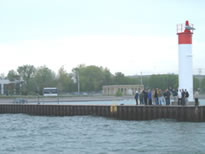
PDQ employees watching departure |
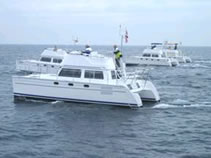
15 PDQ 34's cruising Lake Ontario |
Arriving at Cobourg, we gradually filled up two piers as the 15 PDQ’s tied up side by side. It was a very impressive site indeed.
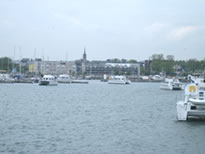
Entering Cobourg Marina |
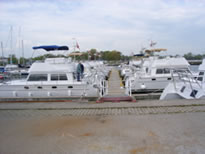
Overnight at Cobourg, Ontario |
PDQ provided a wonderful catered homemade meal at the Cobourg Yacht Club. PDQ owners Deb & Simon Slater drove from Whitby to be with our group. After the group split up for the evening we walked through a section of the beautiful, clean town of 18,000, which is one block from the expansive marina.
Thursday, May 18
The next morning, six of the PDQs left Cobourg at a heading of 110 degrees for Oswego, New York, and the Oswego Canal that would take them to the Erie Canal for their trip south toward Annapolis and beyond.
The other nine boats headed 90 degrees for Presqu’ile Bay and then into the Murray Canal, the official beginning of the Trent Severn. The Murray is a man- made canal linking Presqu’ile Bay to the bay of Quinte at the east end of Lake Ontario.
We cruised about half the distance of the Bay of Quinte where six of the boats headed to the Rideau Canal, Lake Champlain and the east coast. Our three Trawlers Midwest boats headed to Trenton and the Fraser Park Marina.
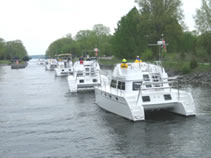
Murray Canal |
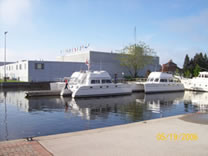
Fraser Park Marina, Trenton, Ontario |
This mooring placed us just below the highway bridge marking the entrance to the Trent Severn. Tomorrow, May 19th, is the first day the Trent Severn is open for traffic for the 2006 season and we hear the crews are still removing the build-up of logs and debri in front of the gates that has accumulated over the winter months.
Arriving early afternoon gave us a chance to walk around the city as a light rain continued to fall. We visited the Chamber of Commerce and the Quinte West Library where we were able to check our emails on their computers. The library houses the city hall and is situated overlooking the bay.
Before we left Coburg this morning, Gloria had started our crock pot of chicken, potatoes, and carrots, which simmered all day with our 2000 watt inverter running. The crock pot dinner was enjoyed by all. It was great to have a person who loves to cook aboard one of our boats.
Friday, May 19
Fog greeted our morning but lifted just before we left the dock and passed under the official “Trent Severn Waterway” arch.
It was only a short distance to the first lock. The lock fees of $153.00 per boat for a one-way pass through the Trent Severn were prepaid so we just needed to pick up our stickers. There are 43 locks on the 240-mile waterway known as the Trent Severn which was completed in the 1920’s. The first 33 Locks have a combined lift of 590 feet. The western ten locks lower the boat 256 feet. |
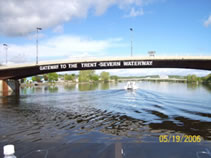
Gateway to Trent Severn |
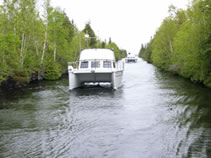
Narrow tree-lined channels
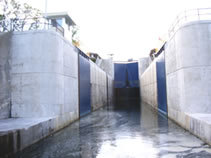
Entering a flight lock |
The first six locks are rather close together and we completed them just past noon. It was a beautiful sunny, jacket-weather day. The next six locks were spread out over a 20-mile stretch. Some areas were lined with cottages and homes near the water. One very narrow section was marshy and other sections were lined with tall trees.
The waterway is very well marked with buoys but in some places the distance between the red & green buoys was only about 20 feet so we had to be very careful. One area was called the “Danger Narrows”, so named because of the rocks adjacent to the channel. Locks 11 & 12 are back to back and are called a flight lock. In the flight lock the front door of the first of the flight serves as the back door of the second lock of the flight. In this lock the middle door is an imposing sight at over 48 feet tall. |
We decided Campbellford would be our stop for the evening. Even though we only covered 30 miles, we were in and out of twelve locks and all felt we had put in a “good day’s work”. There’s a lot of line handling and moving fenders from port to starboard depending on which side the lockmaster needs us to grab the cables on. The unusual currents and wind in the locks also demand a constant vigilance to keep our boats in a safe position in the lock since we are often only a foot or two apart. Approaching Campbellford, we found docking was available along the wall of the town. There was a strong current and a good wind, so it took careful maneuvering to bring the cats snug against the wall.
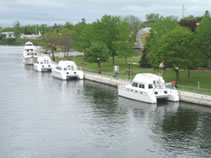
City wall of Campbellford |
Joining us on the wall was the very nice couple from Charlevoix, Michigan, in their 55-foot Fleming. We had also stayed together at Trenton and we knew they were locking through behind us. They joined us for dinner at Capers, a restaurant located in a renovated 19th century home on Bridge Street and within easy walking distance from the boats. The Central Park next to the city wall featured a large sculpture of the “Tooney”, Canada’s two dollar coin that you can see sticking out amongst the trees. |
Saturday, May 20
Heeding advice from the locals, we took advantage of a short walk over the bridge to enjoy breakfast at Tish’s Country Kitchen. A cold front came through during the night and a chilling rain started to fall by the time we pulled away from the wall. We donned our all-weather gear knowing we would be out in the rain going through the locks. Gloria even came prepared with stocking caps and ski gloves, knowing May in Canada is not exactly summer!!
The PDQ’s have a very comfortable inside helm with great visibility all-around and heat off the engine so we could get cozy again between locks. The wide flat side decks and easy-walking steps to the bridge make these boats very ideal for doing locks.
As we left Campbellford, the next five locks were pretty close together and Locks 16 & 17 were another set of flight locks. On the Trent Severn, most of the locks are still manually operated.
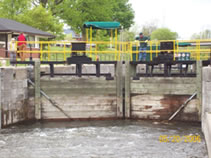
Lock gate & swirling water as it fills |
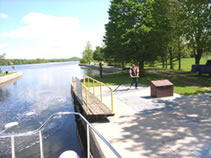
Lockmaster turning crank to open gate |
Closing the gate was done by the lockmaster turning a turnstile with a gear under the lock deck attached to the arm on the lock door. After the gate was fully closed, the lock attendant proceeded to the other end of the lock and manually raised a gate valve built into the lock gate that allowed water to flow from upstream into the lock.
The rain kept changing from a light drizzle to pouring which seemed to happen every time we were in a lock.
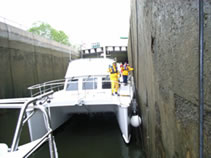
Locking through in the rain |
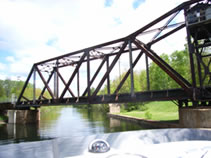
Swing bridge |
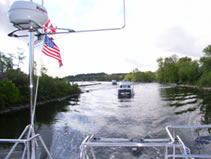
Navigating the Trent River |
We were now on the Trent River with its many switchbacks and we often lost sight of our traveling companions. There were occasional beautiful cottages and here and there a few fishermen.
Approaching a very low bridge, we weren’t sure we could pass under without releasing our collapsible radar mast so Ken and I in the lead boat crept ever so slowly up to it and realized we had about a foot to spare so beckoned our comrades to come on through. Bridge heights can be deceiving but then again, you never want to guess wrong. |
We encountered a half-hour wait at Hastings Lock 18 but our captains did a great job holding the boats off with the strong current. Upon leaving the lock we entered the 20-mile long Rice Lake. It was a nice break to sit back and enjoy the scenery which varied from farms to islands to beautiful tree-covered hills. This lake was created as the rivers were dammed and allowed to fill. Consequently the middle of the lake was only 10 feet deep with the navigable channel well-marked with buoys. From Rice Lake the Otonabee River cuts north and is lined with homes and cottages along the banks for several miles then changes to uninhabited marshland.
Completing 6 locks and 59 miles this day, we are greeted by the beautiful Centennial Fountain with a 250 foot jet of water in the lake marking the entrance to Peterborough Marina.
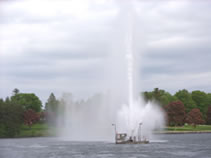
Centennial Fountain at Peterborough |
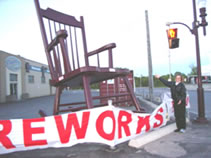
Victoria Day in Peterborough |
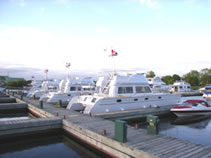
Overnight dockage at Peterborough Marina |
We just happened upon the Kiwanis Carnival including live band music, good food, and later fireworks celebrating Canada’s Victoria Holiday. It added some pleasurable festivity to our trip. A grocery store was in easy walking distance from the Peterborough Marina so we were able to stock up on supplies. |
Sunday May 21, 2006
We pull away from our slips at the Peterborough Marina in a light rain and very chilly air. Locks 20-26 are located very close together so we will spend a good part of our day getting through these. There are already several other smaller boats and a large houseboat waiting at the gate for Lock 20.
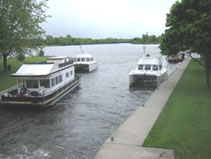
Waiting at Lock 20 |
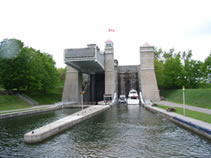
Peterborough Lift Lock |
The lockmasters have to juggle the size (length and width) of boats to fit in as many as possible. Ken & Karen get called in to fill a lock-through and our other two cats are told they will be locking through with the houseboat. This is the first time our 3-boat flotilla will be separated. Turns out the houseboat went in first and had a difficult time grabbing their cables and securing the boat to the wall. Dan & Lou did a great job of controlling their boats in the small space as one took a port tie and the other a starboard tie. There’s always a lot of wind and currents in the locks making it even more challenging. It actually started snowing lightly for a brief time while they were in the lock so I’m told Laura and Gloria sang Christmas carols to compliment the scenery!
A passage of a couple hundred yards brought us to Lock 21, the Peterborough Lift Lock. This lock was as fascinating as people had said it was. It consists of two side-by-side tubs each approximately 150 feet long by 40 feet wide with hydraulic gates at each end. We entered the right tub and tied to the rails strategically place in the tub. Once we were in the tub and the rear gate was closed and locked. The hydraulic valve was then released and the upper left tub which has had 18” of water added and is |
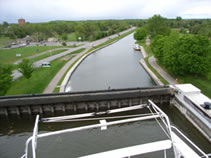
View at the top looking back |
now the heavier tub so it comes down and pushes the lower left tub up. At the next cycle the process reverses and the right tub pushes the left tub up. The Peterborough lock lifts the boats 65 feet above the countryside in about three minutes. Once at the top of the lift, one can see for miles out the back of the tub. Now the front gate opens and we exit at the 65 foot higher river level. This is quite a sight and rather unusual as boating experiences go.
It’s most impressive when you think that this engineering feat was designed in the 1890 time frame. The Peterborough Lift Lock was dedicated in 1904. It is still the largest lift lock in the world, only one of two in the American continents and was one of the largest non-reinforced concrete structures built in its time. It has been refurbished only once-in 1967. There is a road that passes under the lock for the local traffic. As we cruised the short distance between this set of locks we encountered another swing bridge that had to be opened for the three of us as we are now back together. By 3:00 pm we had gone through locks 22, 23, 24, 25, and 26.

All 3 PDQ's fitting in one lock |
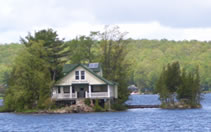
Home on a rock island |
Clearing Lock 27 at Young’s Point, we entered Stony Lake, a large lake with a number of beautiful homes along the shoreline and on islands. It was interesting to note that Canada is experiencing the same housing pressure we experience on waterfront properties in Michigan and Wisconsin. Cottages are being purchased for a hefty price, torn down, and replaced with large modern homes.
At this point in our trip we again encountered lots of rocks, shale and navigational obstructions so it’s time to disengage the autopilot and really pay attention. Leaving Stony Lake we locked through 28 and 30. Lock 29 was added to either 28 or 30; we’re not sure which. It was 6 pm by the time we completed Lock 31 at Buckhorn so we decided to stay on the Lock wall for the night. Gloria had been at her crock pot that morning so not only was it a memorable day, but also a pleasant olfactory event with beef, potatoes and carrots cooking in the pot powered by the inverter. Since we had missed church, we had a short service of song and readings then dinner on PDQ 34-85. We closed out the evening with some card games. What a day to remember!!
Monday, May 22
This was Victoria Day in Canada so many of the stores were not open. It’s good the locks are operating. We were up at 6:30, cleaned the frost off the upper helm seat and were underway after breakfast aboard. We entered Buckhorn Lake and then motored into Pigeon Lake. These lakes were created by the flooding of rivers so the connecting navigation channel was quite narrow but well marked. |
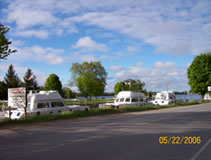
Spent night at Buckhorn Lock |
Lock 32 brought us to Bobcaygeon. This is a quaint resort area that is experiencing the pressures of development. Cottages again are being replaced by monumental homes so the housing stock was very mixed. Many of the properties in this area had boat houses; some of which were in dire need of some tender loving care. We navigated thru Sturgeon Lake, Lock 34 at Fenlon Falls, across Lake Cameron, Rosedale Lock 35 with only a four foot lift and into Balsom Lake.
At this point we were on the top of the Trent Severn and will now be going down hill from here to Port Severn. Rock and shale were becoming more prevalent as we moved mostly west. We did see some natural wild life but mostly birds. The weather was staying cold and windy so the lower helm station was a welcome reprieve between locks.
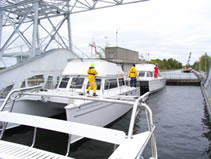
All 3 PDQ's in Kirkland Lift Lock |
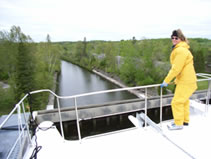
Top of Kirkland Lift Lock at 49 feet |
Our next lock was the Kirkfield Hydraulic Lift Lock 36, the world’s second largest lock of this type, with a lift of 49 feet. In the Peterborough Lock we were the last one in so we had the view to the river below as we went up. In this lock we are the first one in and the lock is at it’s highest level so now it looks like there is nothing in front of us and if that forward gate failed we would be in for quite a ride…eerie feeling!!
Lock number 37 at Bolsover was the first conventional lock where we would be going down instead of up. The lockmaster usually helped attach the line to the lock cable since the freeboard of the boat placed us some four feet above the lock deck. This does make life easier for the crew since we don’t have the trepidation of trying to reach the cable hanging down and getting our line around it to stabilize the boat. We left Bolsover Lock at 2:30, then passed through Talbot Lock 38, Portage Lock 39, Thorah Lock 40 and Cambridge Lock 41. After the lock at Gamebridge, we entered Lake Simcoe. This shallow body of water greeted us with 4-foot waves at very close intervals requiring us to slow to 10 knots for the first half of the15 miles of open water.
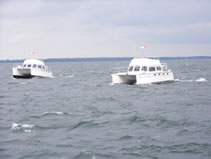
Crossing Lake Simcoe |
The waves gradually subsided to about 2 feet as we entered the narrows at Atherly about 6 pm. We took a slip for the night at Mariposa Landing and had a meal out at Just Eddies. It was noticeably quiet for a Canadian holiday. The marina existed of mostly covered boat slips with an inordinate number of wooden cruisers. We conjectured that the covered slips were necessary to keep the snow off the boats. We again played a couple card games before hitting the sack. |
Tuesday, May 23
We needed to fuel up all three boats so we made a stop in Orilla at Hot Knots Marina. Note that we had been traveling for four days and were just making our first fuel stop. After fueling we entered Lake Couchiching and left the Couchiching Lock 42 at noon. We were back in river beds so lost sight of the lead boat at times as it disappeared around the bends. We crossed Sparrow Lake and then motored at slow speeds in the Severn River. This river also has numerous homes on each shore.
After Swift Rapids Lock 43 we came to the Big Chute Marine Railway, the other spectacular experience to be had on the Trent Severn. One by one boats our boats were loaded on a rail raft-type structure which is then lifted high enough to traverse a road and gradually move down the tracks to the river below.
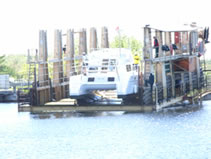
Entering the Big Chute Railway |
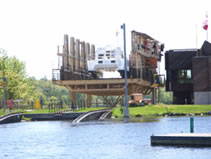
Being lifted on the rail bed |
The PDQ catamaran’s twin hulls with the keel about 12 feet apart can sit very stable on its bottom. Because the four cylinder engines are placed low in the hull, the shaft and propellers are straight out the vertical edge of the keel and well protected. The railway personnel lowered the railcar into the water and we maneuvered our boat onto the railcar deck with the aft hull hanging slightly over the rail bed. Even though we explained the props are high enough to be protected, they still felt safer in having it hang over the back edge of the rail car.
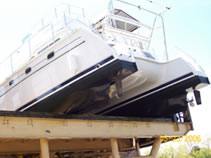
PDQ placement on rail care |
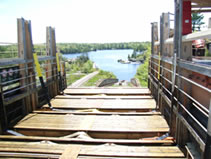
View going forward |
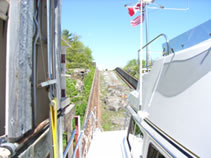
View looking back |
A cable system pulls the boat laden railcar up about 20 feet, over a road, then down about fifty feet and back into the water. The brochure explaining this neat contraption states that the Marine railway was the lowering conveyance of choice because the authorities did not want the lamprey eel to get into Georgian Bay and the Upper Great Lakes. The St. Lawrence Seaway was opened in the 1960’s and sure enough the lamprey got into the lakes even though the people of 60 years ago had tried to prevent that. |
After passing thru the Etang Gloucester Pool we encountered Port Severn Lock 45, our last one for this trip. We traveled another hour and a half and found three slips just beckoning us at the Midland Marina. After a short shopping trip to this highly decorated town with murals painted on many of the buildings, we enjoyed a meal prepared by the cook on PDQ 34-88, our host and leader.
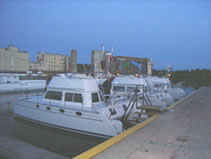
Midland Marina on Georgian Bay at daybreak |
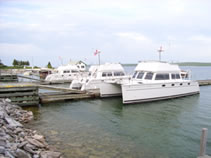
Muldrum Bay Marina |
Wednesday, May 24
We left the marina at 5:30 and watched the sunrise over our starboard side. Since we had flat seas, we traveled at 14 plus knots through the Georgian Bay, past Little Current and into the North Channel. One could spend a whole season exploring the Georgian Bay and the North Channel, but it’s not for us this time. We need to get these boats to our dealership in a certain time-frame and sightseeing will have to wait for a future excursion. We pulled into Muldrum Bay Marina after 7:00 pm and easily found three slips. The only restaurant was closed with a for sale sign prominently displayed. We again had dinner on PDQ 34-85. Even leftovers tasted good after a long day.
Thursday, May 25
We departed Muldrum Bay at 7:30 and stayed on the north side of Manatoulin Island until we reached the False Detour Channel. At this point we asked everyone to slow down because I had to call customs to request clearance over the phone rather than having to cruise out of the way to their office on Drummond Island. This is necessary because we are bringing three Canadian-made boats into the US. I had also called them the day before to tell them of our whereabouts and cruising destination. A nice agent understood our dilemma of not wanting to cruise so far out of the way and to be able to take advantage of relatively calm seas on Lakes Huron & Michigan. He gave us clearance by phone so we turned south on the False Detour Channel into Lake Huron. It was a 70-mile run to Round Island light then over to Mackinac City for fuel at the Schepler Dock. This was our second fuel stop of the trip. Efficient boats indeed! The Mackinac Bridge is a welcome sight as we know we are getting close to home. It is such a marvel of engineering that always makes you gaze at it in awe.
The weather was still overcast with very little wind, so we passed thru Grays Reef toward the north end of Little Traverse Bay and on into Leland. About seven miles out of Leland the fog settled in and we saw rain on the radar. We pulled into Leland Harbor about 6:30 pm in a light rain. There were a few other boats at Leland but not many out this early in the season. We shared another dinner of crock pot cooked corned beef, potatoes, and carrots. One round of Mexican Rummy and then it was off to bed. |
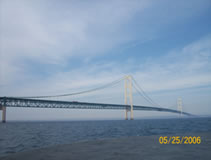
Mackinac Bridge |
Friday, May 26
We awoke early in Leland and left the dock about 6:00 am to get a head start on making the crossing of Lake Michigan. Upon entering Lake Michigan we encountered “pea soup” fog so it was on with the plotter, on with the radar and on with the VHF scanning numerous stations. The radar showed that the three boats were separated by only ¼ mile and as the first boat we could not see the third boat but we could always see each other on radar. Ken & I have crossed Lake Michigan in fog before so we led the way. The weather stayed foggy until about three hours out of Manitowoc and then the sun broke out and gave us a beautiful welcome home.
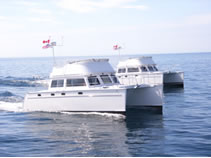
Lake Michigan |
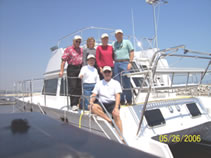
L to R, back: Ken & Karen, Laura & Dan, Gloria & Lou (front) |
We always arrive at our homeport feeling excited to be home but also feeling regret that this great adventure has come to an end. We were thankful to have had safe travels, weather that cooperated most of the time, and such great folks with which to share yet another challenge on the waterways of the Midwest.
Story written by Karen Schuler with detail help from Karen's & Gloria's logs kept during the trip.
Pictures from the Schulers, Draegers, and Cypher's digital cameras. |

